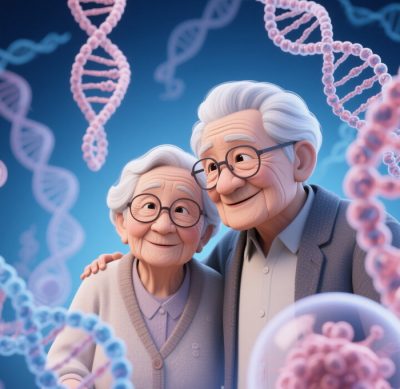
Genetic Technologies and Human Longevity: Breakthroughs, Ethical Challenges, and Future Visions
1. Core Mechanisms of Lifespan Extension via Genetic Technologies
Precision Regulation of Aging-Related Genes
- Gene Repair: CRISPR-Cas9 tools correct progeria-causing mutations (e.g., LMNA) or inhibit pro-aging proteins (e.g., progerin), extending lifespan by over 25% in animal models.
- Epigenetic Reprogramming: SATI and CRISPRoff reverse DNA methylation and other aging markers, restoring youthful cellular functions.
- Longevity Gene Activation: Overexpression of FOXO3, SIRT1, and Cisd2 enhances cellular stress resistance. For example, CG11837 activation boosts human cell resilience by 30%.
Cellular and Systemic Interventions
- Senolysis: Targeted removal of inflammatory “zombie cells” by editing senescence markers like p16INK4a.
- Stem Cell Regeneration: iPSC-derived functional cells combined with 3D-bioprinted vascular networks address tissue degeneration.
2. Current Breakthroughs and Case Studies
| Technology | Key Breakthroughs | Efficacy |
|---|---|---|
| Gene Editing | CRISPR-Cas9 repair of LMNA in progeria mice | 25% lifespan extension |
| Gene Oscillators | Zhou Lab’s yeast aging cycle regulation | 82% lifespan extension |
| Longevity Gene Engineering | CG11837 activation (fruit fly/nematode trials) | 12%-35% lifespan extension |
| Synthetic Biology Circuits | MIT’s closed-loop DBTL system optimization | 500 circuit parameters optimized weekly |
Case Analysis:
- Smart CAR-T Upgrades: Allogene Therapeutics’ AND-gated CAR-T cells activate only in tumor microenvironments, reducing cytokine release syndrome risk to 7%.
- Microbiome Engineering: Engineered E. coli degrades urea, lowering blood ammonia by 60% in hepatic encephalopathy patients via AI-robotic monitoring.
3. Technical Bottlenecks and Ethical Debates
Scientific Challenges
- Off-Target Effects: CRISPR’s nonspecific cuts may cause oncogenic mutations (e.g., p53 pathway dysregulation).
- Polygenic Complexity: Aging involves hundreds of interacting genes, limiting single-target interventions (requires systems biology modeling).
- Delivery Efficiency: AAV vectors struggle to cross the blood-brain barrier, hindering neurodegenerative disease treatments.
Ethical and Philosophical Dilemmas
- Germline Editing: Permanent genetic modifications risk intergenerational inequality and ecological disruption (e.g., “designer babies”).
- Societal Impacts of Longevity: Population imbalance, resource allocation conflicts, and existential questions (“Does immortality dehumanize?”).
- Accessibility: High costs (e.g., $500,000 per CAR-T dose) exacerbate global health inequities.
4. Future Convergence and Strategic Directions
Quantum-Bio Computing Fusion
- DNA Qubits: Microsoft simulates CRISPR dynamics with topological qubits at femtosecond precision.
- AI-Driven Design: DeepMind’s AlphaGeneCircuit generates genetic logic gates with 80% higher success rates than conventional methods.
Lifelong Health Management
- Personalized Anti-Aging: Combines epigenetic clock analysis with gene-metabolome data for tailored dietary/drug interventions.
- Synthetic Organ Factories: Harvard Wyss Institute’s 4D-bioprinted liver tissues enable 28-day drug metabolism testing, advancing toward transplantable organs.
Ethical Governance Frameworks
- Blockchain Registries: Global tracking of synthetic biology devices and gene-editing experiments.
- Dynamic Regulations: FDA’s Accelerated Approval Guidelines for SynBio Therapies (2026) balance innovation and risk.
5. Potential Limits and Timelines for Human Longevity
- Theoretical Maximum: Current models suggest a natural human lifespan limit of ~150 years, extendable to 200+ via gene editing.
- Milestones:
- 2030: Achieve 100-year healthspan by curing age-related diseases like Alzheimer’s.
- 2045: Attain “longevity escape velocity” (annual lifespan gain >1 year) via gene-nanorobot therapies.
Conclusion: From Technological Revolution to Civilizational Transformation
Genetic technologies are redefining human longevity—transforming it from a “product of natural evolution” to a “programmable engineering system.” Beyond extending individual lives, their true value lies in reshaping our understanding of disease, aging, and mortality. However, this progress demands parallel ethical reflection: How do we preserve human dignity amid technological acceleration? The answer may lie in fostering a globally collaborative governance ecosystem, ensuring longevity technologies serve as equitable tools rather than privileges.
Data sourced from publicly available information and subject to verification.





